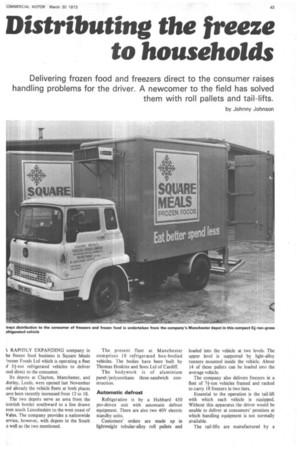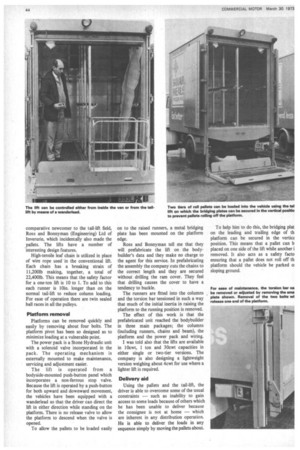Distributing the freeze to households
Page 43

Page 44

If you've noticed an error in this article please click here to report it so we can fix it.
Delivering frozen food and freezers direct to the consumer raises handling problems for the driver. A newcomer to the field has solved them with roll pallets and tail-lifts,
by Johnny Johnson
k RAPIDLY EXPANDING company in he frozen food business is Square Meals 'rozen Foods Ltd which is operating a fleet • f 5f-ton refrigerated vehicles to deliver nod direct to the consumer.
Its depots at Clayton, Manchester, and v1orley, Leeds, were opened last November Lnd already the vehicle fleets at both places rave been recently increased from 12 to 18.
The two depots serve an area from the 'cottish border southward to a line drawn rom south Lincolnshire to the west coast of Vales. The company provides a nationwide ervice, however, with depots in the South L5 well as the two mentioned.
The present fleet at Manchester comprises 18 refrigerated box-bodied vehicles. The bodies have been built by Thomas Hoskins and Sons Ltd of Cardiff.
The bodywork is of aluminium panel/polyurethane three-sandwich construction.
Automatic defrost Refrigeration is by a Hubbard 450 pto-driven unit with automatic defrost equipment. There are also two 4(11( electric standby units.
Customers' orders are made up in lightweight tubular-alloy roll pallets and
loaded into the vehicle at two levels. The upper level is supported by light-alloy runners mounted inside the vehicle. About 14 of these pallets can be loaded into the average vehicle.
The company also delivers freezers in a fleet of 7f ton vehicles framed and racked to carry 18 freezers in two tiers.
Essential to the operation is the tail-lift with which each vehicle is equipped. Without this apparatus the driver would be unable to deliver at consumers' premises at which handling equipment is not normally available.
The tail-lifts are manufactured by a
comparative newcomer to the tail-lift field, Ross and Bonnyman (Engineering) Ltd of Inverurie, which incidentally also made the .pallets. The lifts have a number of interesting design features.
High-tensile leaf chain is utilized in place of wire rope used in the conventional lift. Each chain has a breaking strain of 11,2001b making, together, a total of 22,4001b. This means that the safety factor for a one-ton lift is 10 to I. To add to this each runner is 10in, longer than on the normal tail-lift to reduce column loading. For ease of operation there are twin sealed ball races in all the pulleys.
Platform removal Platforms can be removed quickly and easily by removing about four bolts. The platform pivot has been so designed as to minimize loading at a vulnerable point.
The power pack is a Stone Hydraulic unit with a solenoid valve incorporated in the pack. The operating mechanism is externally mounted to make maintenance, servicing and adjustment easier.
The lift is operated from a bodyside-mounted push-button panel which incorporates a non-ferrous stop valve. Because the lift is operated by a push-button for both upward and downward movement, the vehicles have been equipped with a wanderlead so that the driver can direct the lift in either direction while standing on the platform. There is no release valve to allow the platform to descend when the valve is opened.
To allow the pallets to be loaded easily on to the raised runners, a metal bridging plate has been mounted on the platform edge.
Ross and Bonnyman tell me that they will prefabricate the lift on the bodybuilder's data and they make no charge to the agent for this service. In prefabricating the assembly the company cuts the chains to the correct length and they are secured without drilling the ram cover. They feel that drilling causes the cover to have a tendency to buckle.
The runners are fitted into the columns and the torsion bar tensioned in such a way that much of the initial inertia in raising the platform to the running position is removed.
The effect of this work is that the prefabricated unit reached the bodybuilder in three main packages; the columns (including runners, chains and beam), the platform and the power pack and wiring.
I was told also that the lifts are available in lOcwt, 1 ton and 30cwt capacities in either single or two-tier versions. The company is also designing a lightweight version weighing about 4cwt for use where a lighter lift is required.
Delivery aid Using the pallets and the tail-lift, the driver is able to overcome some of the usual constraints — such as inability to gain access to some loads because of others which he has been unable to deliver because the consignee is not at home — which are inherent in any distribution operation. He is able to deliver the loads in any sequence simply by moving the pallets about. To help him to do this, the bridging plat on the leading and trailing edge of th platform can be secured in the vertia position. This means that a pallet can b placed on one side of the lift while another i removed. It also acts as a safety facto ensuring that a pallet does not roll off th platform should the vehicle be parked a sloping ground.










































































































